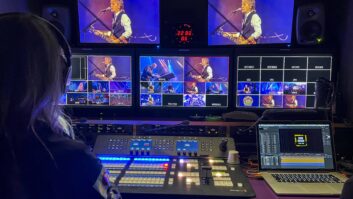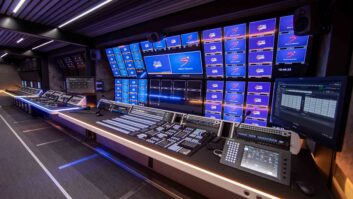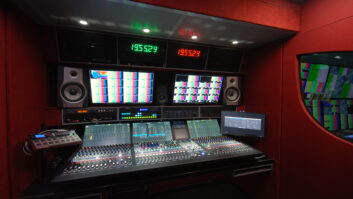The broadcast production for Wimbledon needed to be a well-oiled operation simply in order for all the OB vehicles, cameras, cabling and myriad of de-rigged galleries to fit together inside the manicured, close quartered compounds of the All England Lawn Tennis Club, without disrupting 40,000 paying punters, writes Adrian Pennington.
Channels in more than 150 countries took live or recorded programming from this year’s Championships, all of which passed at some point through a sophisticated logging system devised and run by Timeline TV on behalf of the AELTC and its international clients managed by IMG Media including BBC, NBC, Channel 7, Fox, The Tennis Channel, BBC News and BBC Interactive.
Timeline takes each match (acquired by SIS Live on behalf of host broadcaster BBC) as both dirty and clean feeds, along with all press conferences, and augments that with six ENG crews roaming with P2 camcorders for practice sessions, warm-ups, crowd and beauty shots. In addition two ISO feeds on each of Centre Court and Court One track each player throughout the game and a dirty and clean version of these comprise clips lasting the duration of each match.
“The EVS operators in the host operation also archive shots that they think are particularly good – slow mos, good serves for example – and that comes to us as a separate compilation log, between five minutes to an hour for Centre Court action each day,” explained Daniel McDonnell, Managing Director, Timeline TV.
All of this material was ingested to 16 HD EVS XT servers ganged together in the bowels of the Broadcast Centre. Recording was made at 1080i in ProRes 120Mbps and simultaneously as low-res MPEG 6Mbps to a nearline 120TB server to which all rights holding broadcasters have access.
The interface for them is one of 60 EVS IPDirectors, which combine live point-by-point statistical/score information gathered either automatically from radar or from IBM’s courtside loggers with broadcast-applicable metadata tagged round the clock by Timeline’s specialists.
The producer-entered classifications provides colour to the edits, such as star ratings, players’ actions between points and close-up reaction shots of the crowd. Once a user finds a clip they can route it to their Avid or FCP craft system, transcoded as necessary into DNx.
For the first time Timeline was able to offer instant access to archive footage from all televised matches from the 2007-2010 tournaments. IMG Media, which owns the rights to the Wimbledon archive, loaded compilations of previous tournament matches onto the nearline server, already fully logged footage on its own EVS servers in Chiswick, for access by the IPDirector terminals in the Broadcast Centre.
“There is so much we can do with the data we are collecting,” said McDonnell. “That is the next stage if you like – using data to generate some more income for broadcasters or the AELTC to produce more and better programming.”
One idea is a mobile app that audiences at Wimbledon could access alongside a diagram of a court to select which camera angle they wanted to view.
“You could allow them to keep up to date on action on other courts, follow live scores,” said McDonnell. “Live betting applications are another opportunity.”
A 3D first Service
On the 3D side this was the first year of a three-year deal Sony signed with the AELTC and the production was treated as a test to make sure all parties, the BBC and AELTC were happy.
“We’ve taken a very softly, softly approach,” said CAN Communicate creative director Duncan Humphreys. “The big change since the World Cup is that we are working with a much more integrated system. When we scoped the job we were doing so not just for these two weeks, but for what might be required in future. We think twin production areas will be in huge demand for next year and the Gemini trucks allow us to do that – it is scaleable.”
The Gemini trucks were launched by NEP Visions last autumn and designed with a stereo future in mind. Connected with 10 Stratos Multicore fibres for full talkback and router integration, they total 1400sq feet of floor space and are equipped with two Grass Valley Kalypso Duo Vision Mixers with 90 inputs, and a million pounds worth of 3-Gbps Evertz router capable of taking in feeds from 30 cameras.
“We have convergence and EVS in one and production in the second but they are designed to work together,” explained Brian Clark, NEP Visions’ Commercial Director. “Both trucks have a unique expanding infrastructure, so that the outer shell expands the trailer to give us about 65 square meters extra per truck.”
Part of that was taken up with a full Quantel Pablo suite for Sony to craft 3D packages for its retail stores. Other parts of the truck’s 3D makeover included monitoring and installation of the MPE-200 3D processors, but the infrastructure is essentially the same.
“We are reasonably agnostic to the 3D technology,” said Clark. “NEP in the US helped develop the HDFA-200 fibre combiners (which enable a pair of 3D cameras to work down a single fibre) and MPE software and our US trucks worked closely with ESPN last year. We are trying to work out what is best for the market and start from an understanding that 3D is about how quick you can get in, how quick can you rig and then how quick you can repurpose the rigs for another operation. We are confident we have achieved that with our design and our crew and that we have the resource in the UK to take on 3D contracts.”
The 3D signal was 1080i out of the back of the truck uplinked by Globecast and transmitted in side-by-side mode to consumers, and also encoded as 720p for projection in 250 RealD-equipped cinemas.
www.cancommunicate.com
www.imgworld.com
www.sislive.tv
www.sony.net
www.timeline.tv
www.visions-ob.com







